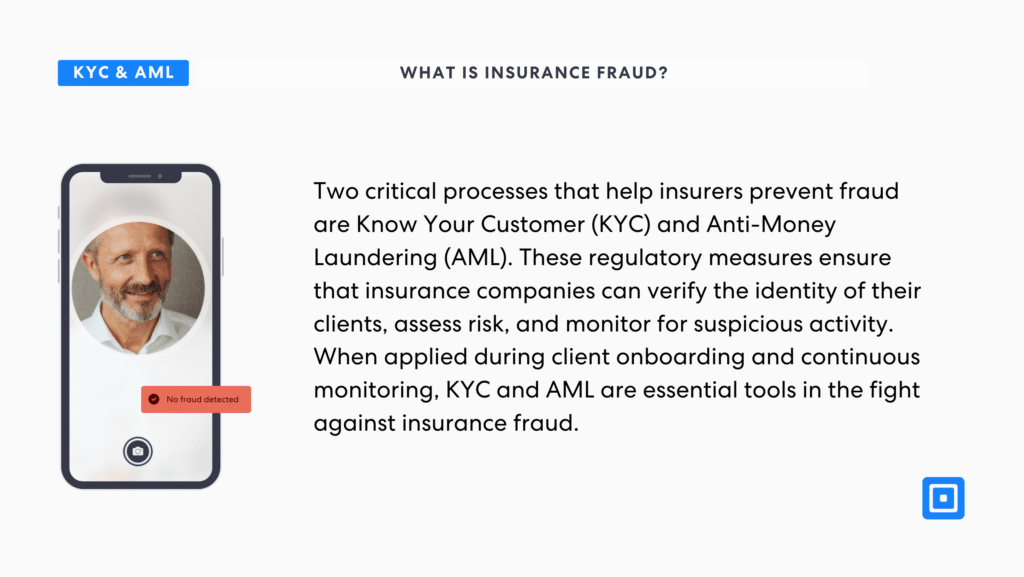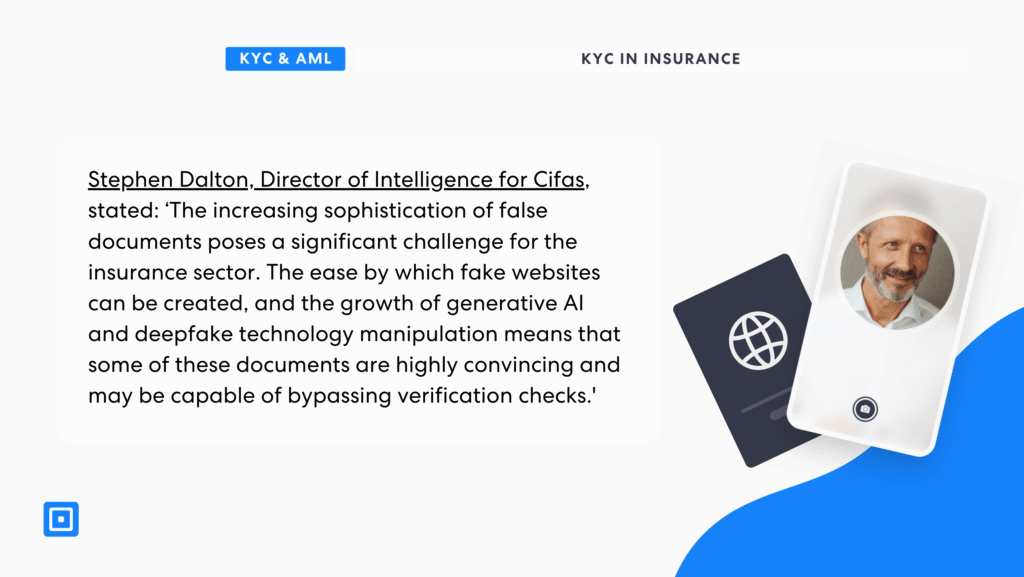What is insurance fraud? Insurance fraud is a serious issue that costs the insurance industry billions of dollars each year. It occurs when individuals or businesses intentionally deceive insurance companies to receive benefits or compensation they are not entitled to. Insurance fraud not only results in financial losses for insurers but also leads to higher premiums for honest policyholders. To combat this growing problem, insurance companies must implement rigorous processes to prevent fraud, particularly during the client onboarding phase and while monitoring clients throughout the duration of their coverage.
Two critical processes that help insurers prevent fraud are Know Your Customer (KYC) and Anti-Money Laundering (AML). These regulatory measures ensure that insurance companies can verify the identity of their clients, assess risk, and monitor for suspicious activity. When applied during client onboarding and continuous monitoring, KYC and AML are essential tools in the fight against insurance fraud.

What is Insurance Fraud?
Insurance fraud involves various activities in which a policyholder or applicant misrepresents or withholds information to gain unauthorized financial benefits. It refers to any intentional act committed to deceive or mislead an insurance company during the application or claims process.
The increasing sophistication of false documents poses a significant challenge for the insurance sector.
The Association of British Insurers detected £1bn in fraudulent claims in a 2024 report, with Cifas arguing that the continuing sophistication of false documents seems to be strengthening fraudulent attempts. Stephen Dalton, Director of Intelligence for Cifas, stated: ‘The increasing sophistication of false documents poses a significant challenge for the insurance sector. The ease by which fake websites can be created, and the growth of generative AI and deepfake technology manipulation means that some of these documents are highly convincing and may be capable of bypassing verification checks.’ Some common types of insurance fraud include:
- False Claims: This occurs when individuals or businesses submit fabricated or exaggerated claims, such as claiming non-existent damages or inflating the value of property loss.
- Premium Fraud: Fraudulent policyholders might provide inaccurate details, such as misreporting their health status, profession, or driving history, in order to secure lower premiums.
- Exaggerated Losses: Policyholders may exaggerate the extent of damage or loss to receive a larger payout than what is legitimately due. Individuals may also falsely claim their car has been stolen or misrepresent the primary driver to obtain lower insurance rates.
- Corporate Fraud: In the corporate sector, businesses may misrepresent their financial status, asset values, or losses to submit fraudulent claims for large-scale events like business interruptions.
Insurance fraud is a serious crime that can have severe consequences for both individuals and companies. Businesses within the insurance sector are implementing increasingly sophisticated customer identification programs and customer due diligence measures to prevent fraud and protect honest customers. By verifying identities and ensuring the individual is who they claim to be, insurance businesses can accurately assess the risk level of customers and determine the legitimacy of their claims. This process not only helps prevent fraudulent activities but also ensures that the appropriate coverage is provided to genuine customers.

Types of Fraud
Insurance fraud can be classified into different types, including hard fraud and soft fraud. Hard fraud occurs when someone deliberately plans or invents a loss, such as a collision or fire, to make a false insurance claim. Soft fraud, on the other hand, involves exaggerating or misrepresenting information to obtain a higher claim payout. Both types of fraud are illegal and can lead to serious consequences for those who commit them. Other forms of insurance fraud include ghost broking, where fraudsters sell fake or illegally obtained insurance policies, and crash for cash scams, in which individuals stage accidents to make false insurance claims.
Rigorous customer vetting and continuous monitoring ensure a more transparent risk assessment process, deterring fraudulent activities from the outset and fostering a safer, more reliable insurance environment.
Harry Varatharasan, Chief of Product at ComplyCube, states, “By enhancing Know Your Customer (KYC) and Anti-Money Laundering (AML) measures, insurance companies can significantly reduce both soft and hard fraud. Rigorous customer vetting and continuous monitoring ensure a more transparent risk assessment process, deterring fraudulent activities from the outset and fostering a safer, more reliable insurance environment.”
How Can Increased Verification Help?
Increased verification plays a pivotal role in preventing various cases of insurance fraud, including ghost broking and crash for cash scams. Ghost broking, where fraudsters sell fake or illegally obtained insurance policies, can be mitigated through robust identity verification processes, such as KYC checks and biometric authentication, ensuring that individuals purchasing policies are who they claim to be.
These measures help prevent fraudsters from using stolen or fabricated identities to obtain policies. Similarly, in crash for cash scams, where fraudsters stage accidents to make false claims, enhanced verification helps by confirming the legitimacy of the individuals involved in the accident through biometric checks and cross-referencing with vehicle and accident databases.
Additionally, AI and machine learning tools can detect suspicious patterns, such as repeated claims or discrepancies in accident details, further safeguarding against fraudulent activities. By implementing these advanced verification methods, insurance companies can more effectively identify and prevent fraud, ensuring that only legitimate claims are processed while protecting both insurers and honest customers.
The Role of KYC and AML in Insurance
Client onboarding is the first and most important step in ensuring compliance and preventing fraud. When a new client applies for insurance, it is crucial for the insurer to verify the identity of the individual or business and assess the risk level associated with providing coverage. KYC and AML processes are central to this task. KYC regulations ensure compliance for banks and other financial institutions, helping to mitigate fraud risks and prevent illegal activities such as money laundering and terrorism financing. For more information on KYC and AML checks to strengthen onboarding, read KYC Checks For a Secure Onboarding Process.
Know Your Customer (KYC)
KYC refers to the process of verifying the identity of a client before providing insurance coverage. This process helps insurance companies make sure that they are not unknowingly engaging with fraudulent or high-risk clients. Here’s how KYC is used during client onboarding:
- Identity Verification: The first step in KYC is confirming that the client is who they claim to be. Insurers collect information such as government-issued identification, proof of address, and company registration documents (for businesses) to prove their identity. This step prevents identity theft, making it harder for fraudsters to use fake identities to obtain coverage.
- Assessing Risk Profiles: Once a client’s identity is verified, the insurer must evaluate their risk level. For individuals, this may involve reviewing factors such as their health history or driving record. For businesses, it might include checking financial stability, industry risk factors, and claims history. This process helps insurers identify high-risk clients who might be more likely to commit fraud. Financial institutions adhere to regulatory frameworks to ensure compliance with KYC processes, enhancing the overall security and reliability of the system.
- Understanding the Client’s Intent: KYC processes also gather information about the client’s purpose for purchasing insurance. By understanding their needs, insurers can better assess whether the client is at a higher risk for fraudulent behavior. For example, a client purchasing an unusually high amount of coverage for assets that appear to be undervalued might raise red flags.
- Enhanced Due Diligence for High-Risk Clients: In some cases, insurance companies may need to conduct enhanced due diligence (EDD) for clients who present a higher risk. This includes clients with complex financial backgrounds or those in high-risk industries. Enhanced scrutiny ensures that these clients are not using insurance policies for illicit purposes.
Anti-Money Laundering (AML)
AML refers to the processes used to detect and prevent money laundering, the process of concealing the origins of illegally obtained money. Insurance companies must implement AML measures to prevent fraud and ensure that they do not inadvertently facilitate criminal activity. Here’s how AML is applied during the client onboarding process:
- Client Screening: Insurance companies screen new clients to check whether they are listed on global sanctions lists or have a criminal history. This process helps ensure that clients involved in illegal activities are not able to gain access to insurance products. By checking against databases of known criminals or organizations involved in fraudulent activity, insurers reduce the likelihood of engaging with fraudsters.
- Source of Funds Verification: When dealing with high-value policies or corporate clients, insurers need to verify the source of funds. For example, if a business applies for large coverage, the insurer may need to ensure that the company’s financial resources are legitimate and not derived from illegal activities.
- Monitoring Politically Exposed Persons (PEPs): Politically exposed persons, who may have access to significant wealth or influence, require additional scrutiny during onboarding. This is because PEPs may be involved in higher-risk activities, including fraud, corruption, or money laundering. AML protocols ensure that these individuals are thoroughly vetted.
- Recording and Reporting Suspicious Behavior: If any part of the onboarding process raises concerns about the legitimacy of a client or their intent, insurers are required to report this suspicious activity to the relevant authorities. This process helps prevent fraud before it even occurs.
Monitoring Clients to Prevent Ongoing Fraud
Client monitoring is an essential part of fraud prevention. Fraudulent activities lead to significant monetary losses for insurance companies, resulting in higher premiums for honest customers, thereby increasing overall insurance costs for the general public. Even after a client has been onboarded and coverage has been issued, it is vital for insurance companies to continuously monitor their clients’ behavior and transactions to detect any signs of fraudulent activity. Data is essential for conducting KYC checks and ensuring compliance with financial regulations. KYC and AML systems support this ongoing surveillance by flagging anomalies and suspicious transactions.
Know Your Customer (KYC) – Continuous Monitoring
Once a client is onboarded, insurers need to ensure they remain compliant with regulations and detect any signs of fraudulent activity throughout the life of the policy. KYC provides the foundation for continuous monitoring by:
- Updating Client Information: KYC is not a one-time process. Insurers should periodically update their clients’ personal and financial information to ensure it remains accurate. This is especially important for high-risk clients whose circumstances may change, potentially increasing the risk of fraud.
- Tracking Claims History: By maintaining detailed records of a client’s claims, insurers can identify patterns that suggest fraud. For example, frequent or exaggerated claims might indicate that a client is attempting to abuse the system. Due to the high volume of claims, insurance companies cannot review all claims, so they focus on those flagged as suspicious for further evaluation. KYC processes help track these behaviors, ensuring timely intervention when needed.
- Risk-Based Monitoring: Clients who were flagged as high-risk during the onboarding process require more intense monitoring. These clients may undergo additional scrutiny whenever they file claims, request policy changes, or engage in financial transactions.
The consequences of lacking effective KYC (Know Your Customer) processes for insurance companies can be severe, leading to increased vulnerability to fraud, which in turn raises insurance premiums for honest customers, results in financial losses for both individuals and businesses, and damages the reputation of the insurance industry.
Fortify Your KYC with ComplyCube
Insurance fraud is a significant threat to the financial stability of the insurance industry, but with the right measures in place, it is possible to mitigate this risk. KYC and AML checks, particularly during client onboarding and continuous monitoring, are essential tools for preventing fraud. These processes allow insurers to verify the identity of their clients, assess their risk profiles, and detect suspicious behavior throughout the duration of the client’s relationship with the company. By applying these measures rigorously, insurance companies can protect themselves, their clients, and the broader financial system from the damaging effects of fraud.
For more information on how to fortify your business with cutting-edge KYC and AML, get in touch with our expert compliance team.




